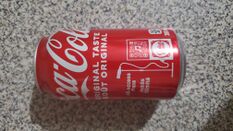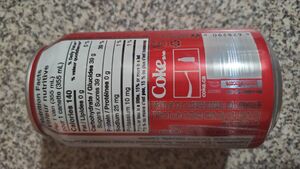Course:FNH200/Assignments/2022/Coca-Cola Original vs Zero Sugar/Caffeine



Introduction
The products we have chosen to compare are the original Coca-Cola[1] and the Coca-Cola Zero Sugar Zero Caffeine[2] alternative. Coca-Cola is a popular carbonated drink and many people around the world drink it, but the "zero" options are also becoming increasingly popular as it is has options such as no sugar, calories, and/or caffeine. One thing to note is that Coke Zero Sugar Zero Caffeine should not be confused with Diet Coke[3] or Coke Zero Sugar[4], which still contains caffeine. We will compare and contrast the two products to see how the zero sugar/caffeine product is different from the original, while still having a similar taste and popularity.

Ingredient lists
Original Ingredients:
Carbonated water, Sugar/ glucose-fructose (high fructose corn syrup), Caramel colour, Phosphoric acid, Natural flavour, Caffeine.[1]
Zero Sugar/Zero Caffeine Ingredients:
Carbonated water, Caramel colour, Phosphoric acid, Aspartame (contains Phenylalanine), Potassium benzoate, Natural flavour, Potassium citrate, Acesulfame-potassium.[2]
| Original Coke | Coke Zero |
|---|---|
| Sugar (high fructose corn syrup) | Sugar substitute (aspartame, acesulfame-k) |
| Caffine | - |
| - | Potassium citrate |
| - | Potassium benzoate |


Fat Substitute, Sugar Substitute, and Food Additive
There is no fat substitute found in the ingredient list.
Sugar Substitute
The sugar substitute, aspartame, is used in Coke Zero. It has only 4 calories per gram and the manufacturer only needs a very small amounts to sweeten the product. Aspartame is 180-200 times sweeter than sucrose[5]. This ingredient makes Coke Zero more attractive to people who want to reduce their calorie and sugar intake. With the aspartame in Coke Zero, people with illness such as diabetes can now enjoy Coke like others do. Several downside has been found with aspartame usage. Some examples are: patient with PKU (phenylketonuria) need to avoid products contain aspartame[5], aspartame may also make the consumer hungrier and eat more food which later lead to weight gain in the future [6]. Aspartame can not undergo caramelization like sugar does because it degradute under high temperature[7] . Therefore, using Coke Zero instead of Coke Original in cooking will not produce the same taste.
Another sugar substitute in Coke Zero is acesulfame-potassium, as known as acesulfame-K. It is a sweetener with high levels of stability in temperature and pH. It is 200 times sweeter than sucrose with 0 calories per gram and it will not cause cavities[5]. It has a slightly bitter aftertaste, therefore it is usually mixed with other sweeteners such as aspartame.[8] It is also associated with health concerns, such as cancer, hormone disruption, and risks to pregnant people.[8]
Food Additives
The food additives that present in the products are caramel colour, phosphoric acid, potassium benzoate and potassium citrate.
Caramel colour is used in both original Coke and Coke Zero. It is widely used in many different food product. In Coke, caramel colour contributed to their signature dark brown colour and improve the appearance (colour) of the product.
Phosphoric Acid and Potassium Benzoate is used as preservatives to extend the product's shelf life, but only phosphoric acid is used in both original and Coke Zero. Phosphoric acid gives the tangy taste to the drink [9] which may exaggerate the flavour of the drink. Potassium Benzoate prevents the growth of micro-organisms such as bacteria, yeast and some mold [10] that may shorten the expiry taste.
Potassium Citrate is used to give a tart, citrus flavour to Coke Zero. It may helped with balancing the sourness and the sweetness after using sugar substitutes[11].
Carbonated water, caramel colour, phosphoric acid, and natural flavour are presented in both products. However, in Zero Brand which promote as a more healthy, zero-sugar product, aspartame replace the role of the sugar/glucose-fructose in Original, and caffeine is also not listed on Zero.
Also, potassium benzoate and potassium citrate only present in Zero. This is because sugar is a nature preservative[12], and is more flavourful than aspartame[11], therefore Potassium Citrate is added to improve the taste, and potassium benzoate is added to improve the shelf life.
Labels
The information on both labels complies with the regulatory requirements in Canada. This information can be found below.
| ORIGINAL | SUGAR/CAFFEINE FREE | |
|---|---|---|
| Bilingual labelling | Both English and French | Both English and French |
| Common name of the food | COCA-COLA | COCA-COLA ZERO SUGAR/ZERO CAFFEINE |
| Country of Origin | Originates from the USA but product was bottled in Canada | Originates from the USA but product was bottled in Canada |
| Date marking | Has a best before date on bottom of can | Has a best before date on bottom of can |
| Storage Info | N/A Lasts longer than 90 days | N/A Lasts longer than 90 days |
| Identity and Principal Place of Business | Coca-Cola company, HQ is in Atlanta, Georgia (USA) but it is a worldwide brand. | Coca-Cola company, HQ is in Atlanta, Georgia (USA) but it is a worldwide brand. |
| Irradiated foods | N/A | N/A |
| Legibility and location | Labels are legible and visible on the side of each can | Labels are legible and visible on the side of each can |
| List of ingredients/ Nutrition Table | Ingredients are listed on the side of the can in descending order
Nutrition Facts Table includes calories, fat, carbs, sugar, protein, sodium, potassium. There is 24mg of caffeine and 100 calories per 250mL of original Coca-Cola. |
Ingredients are listed on the side of the can in descending order. special considerations for
aspartame and acesulfame-potassium (lists mg in can for each) Nutrition Facts Table includes calories, fat, carbs, sugar, protein, sodium, potassium. There is zero caffeine and zero calories. |
| Net quantity of the food | Shows mL per 1 can | Shows mL per 1 can |
| Sweeteners | Sugar = glucose-fructose | Aspartame and Acesulfame-potassium |
| Other Info and Claims | "ORIGINAL TASTE" | "ZERO SUGAR", "ZERO CAFFEINE", "CALORIE FREE COLA"
Aspartame contains phenylalanine |
References
Please use the Wikipedia reference style. Provide a citation for every sentence, statement, thought, or bit of data not your own, giving the author, year, AND page.
Note: Before writing your wiki article on the UBC Wiki, it may be helpful to review the tips in Wikipedia: Writing better articles.[13]
- ↑ 1.0 1.1 "Original Coca-Cola".
- ↑ 2.0 2.1 "Coca-Cola Zero Sugar Zero Caffeine".
- ↑ "Diet Coke".
- ↑ "Coca-Cola Zero Sugar".
- ↑ 5.0 5.1 5.2 Skura, Brent. "Types of Sugar Substitutes - Sweeteners". UBC wiki. Retrieved Jul 18, 2022.
- ↑ Sandoiu, Ana (November 25, 2016). "Diet soda sweetener may cause weight gain". Medical News Today. Check date values in:
|archive-date=(help) - ↑ "Do sweeteners caramelize?". Oven Via. January 28, 2022.
|first=missing|last=(help) - ↑ 8.0 8.1 "Is Acesulfame Potassium Bad for Me?". healthline. May 24, 2022.
- ↑ "Why is phosphoric acid used in some Coca‑Cola drinks?". Coca Cola Great Britain.
- ↑ "What Is Potassium Benzoate? Uses, Foods, and Side Effects". healthline.
- ↑ 11.0 11.1 Froek, Barbara. "Soft Drinks with Potassium Citrate". LIVESTRONG.COM.
- ↑ Williams, Treva. "Preserving Food With Less Sugar". Ohioline.
- ↑ En.wikipedia.org. (2018). Writing better articles. [online] Available at: https://en.wikipedia.org/wiki/Wikipedia:Writing_better_articles [Accessed 18 Jan. 2018].
| This Food Science resource was created by Course:FNH200. |
